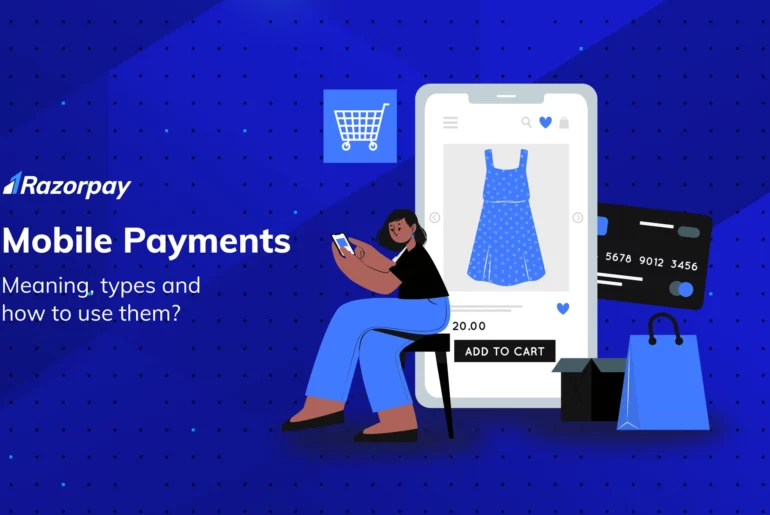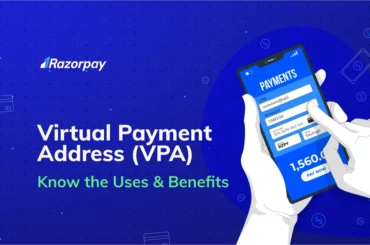The adoption of mobile payments has emerged as a game-changer for business owners and consumers. Unlike traditional payment methods, mobile payments utilise digital platforms, making financial transactions more convenient and secure. In 2024, the ecosystem of mobile payments has matured further, with innovative features and enhanced security measures becoming the norm.
This comprehensive guide will take you through the types, benefits and practical usage of mobile payments to help you navigate the world of financial transactions with ease and confidence.
Table of Contents
What are Mobile Payments?
Let’s understand what is a mobile payment. Mobile payments refer to the ability to make financial transactions using smartphones, tablets, or other mobile devices. It allows you to send money to people, make payments through apps, and use various methods such as cards, UPI and QR codes to pay through mobile devices.
Mobile payments leverage technology to securely transmit information from a mobile device to a merchant’s payment system. This can be done through channels like NFC (Near Field Communication), which enables contactless payments by tapping the device on a compatible payment terminal. Additionally, mobile wallets like Google Pay and Apple Pay store credit card information securely and allow you to make payments online or at physical stores.
One prominent aspect of mobile payments is the ability to engage in peer-to-peer transactions, allowing you to transfer money directly to a friend or merchant without the need for traditional banking intermediaries. This method can involve various payment modes, including credit cards, debit cards, NetBanking, and even point-of-sale systems for in-person purchases.
Mobile payments have evolved significantly over the years. It started with basic SMS-based payment systems and has grown to include advanced technologies like NFC and biometrics for secure authentication. The adoption of UPI (Unified Payments Interface) in India has revolutionised mobile payments by enabling seamless peer-to-peer transactions directly from bank accounts.
Benefits of Mobile Payments
Mobile payments offer several benefits for individuals and businesses alike. Here are some key advantages you can enjoy by adopting mobile payment systems:
1. Elimination of physical wallets
Mobile payments reduce the need for cash, making it more convenient to complete purchases anytime, anywhere. This eliminates the hassle of carrying exact change and reduces the risk of theft.
Related Read: How To Make UPI Payment Without Internet?
2. Enhanced security features
Mobile payment systems utilise advanced security measures such as Touch ID, fingerprint authentication and passwords to ensure secure transactions. These methods offer a higher level of protection compared to cash.
3. Two-factor authentication (2FA)
Mobile payments often have additional layers of security, such as 2FA and OTPs (one-time passwords), which protect against payment fraud and unauthorised access.
4. Speedy transactions
Mobile payments enable quick and seamless transactions. With just a few taps on your smartphone screen, you can complete a payment within seconds.
5. Easy setup and convenience
Setting up mobile payment apps is straightforward, requiring only a few simple steps to link your bank account or credit card. Once set up, you can easily make payments with just a few taps on your device, saving time and effort.
Types of Mobile Payments
Mobile payments encompass various methods for conducting digital financial transactions using mobile devices. The process generally involves linking your bank account or credit card to the mobile payment platform, selecting a recipient or merchant, and confirming the transaction using your device.
1. Mobile Wallets
Mobile wallets are digital apps that allow you to store and manage your payment information securely on your mobile devices. They function as virtual wallets, enabling you to make payments and transfer funds. Mobile wallets can be used for in-store or online purchases, peer-to-peer transfers, and bill payments. Examples of popular mobile wallet apps include Apple Pay, Google Pay, Samsung Pay and PayPal. They provide convenience and versatility by allowing you to make contactless payments, scan QR codes, or send money to friends, all within a single app.
Mobile wallets have evolved, with various technologies adopted to enhance security and convenience. Initially, barcode-based wallets gained popularity for scanning QR codes. Later, NFC technology allowed for contactless payments by tapping the mobile device near a payment terminal. Biometric authentication, like fingerprint or facial recognition, has further improved security. These innovations have transformed mobile wallets into comprehensive tools for digital finance management.
2. NFC Payments
NFC payments utilise compatible devices like smartphones, smartwatches or cards with NFC chips to enable secure and seamless transactions. With NFC technology, you can simply tap your device on a payment terminal to complete a transaction. To set up NFC-enabled devices, ensure the feature is enabled in the settings.
Security measures such as encryption and tokenisation protect sensitive data during these transactions. The advantages of NFC payments include quick and convenient transactions, reduced need for physical cards, and enhanced security against fraud.
3. P2P Payment Apps
Peer-to-peer (P2P) payment apps facilitate seamless and convenient money transfers and transactions. These apps allow you to send and receive funds directly from your smartphones, eliminating the need for traditional methods like cash or cheques. With P2P payment apps like the Razorpay mobile app, you can easily split bills with friends, pay back borrowed money, or even pay local vendors.
4. SMS payments
SMS payments are a type of mobile payment system that enables hassle-free and secure transactions using text messaging. Typically, you need to register with a mobile payment provider and link it to your bank account or card. You can then send payment links via SMS, and the cost may get billed to your mobile carrier. With the widespread use of text messages, SMS payments are convenient for making purchases, donations and bill payments.
5. Mobile Point of Sale (mPOS)
Mobile point-of-sale systems are revolutionising modern business transactions. With mPOS technology, you can turn your smartphone into a portable cash register, allowing you to accept payments anytime, anywhere. This flexibility is especially beneficial for small businesses or merchants who require mobility in their operations. With mPOS technology, businesses can conduct sales, accept payments and manage inventory using mobile devices like smartphones and tablets.
Incorporating Mobile Payments for Your Business
Incorporating mobile payment solutions into your business strategy is no longer just an option – it’s a necessity. It enables your business to accept payments through smartphones, tablets, and other mobile devices, which is increasingly becoming the most common payment method.
As a business owner, you have diverse options for accepting mobile payments, including mobile wallets, NFC payments, mPOS systems, and in-app payments (customers can make payments directly within your business’s dedicated app, eliminating the need for an external mobile app payment gateway).
Future of Mobile Payments
The future of mobile payments is promising, with advancements in technology, ease of use, enhanced security measures, and continuous innovation. Mobile payment systems are becoming more sophisticated with time, offering a seamless and convenient experience. With the rise of mobile app payment gateways like the Razorpay mobile app, businesses can easily accept UPI payments, NFC payments and payments via POS terminals to provide a streamlined checkout process. As the landscape of digital transactions evolves, mobile payments will continue to revolutionise how you make purchases.
Frequently Asked Questions
1. What do you mean by mobile payment?
Mobile payment refers to making payments for goods and services using a mobile device, such as a smartphone or tablet, instead of cash or physical credit cards.
2. What is an example of mobile payment?
An example of mobile payment is using a smartphone to purchase goods at a retail store or online. This can involve apps like Apple Pay, Google Pay or similar banking apps, where you link the payment method to your phone and complete transactions by tapping or scanning.
Related Read: What To Do If Your Google Pay Transaction Fails: How To Fix Payment Problems?
3. How do I pay with mobile payments?
- Download a mobile payment app, such as the Razorpay app, from the Google Play Store or Apple App Store.
- Create an account. Ensure you choose a strong password and enable two-factor authentication for added security.
- Link your bank account to the mobile payment app by providing the necessary details.
- If using a mobile wallet, load money from your bank account or debit card.
- Make payments by selecting mobile payment at online checkout or scanning a QR code at a physical store. You need to authorise the transaction via biometric authentication or a PIN.
- Once the transaction is successful, you will receive a confirmation message or notification.



